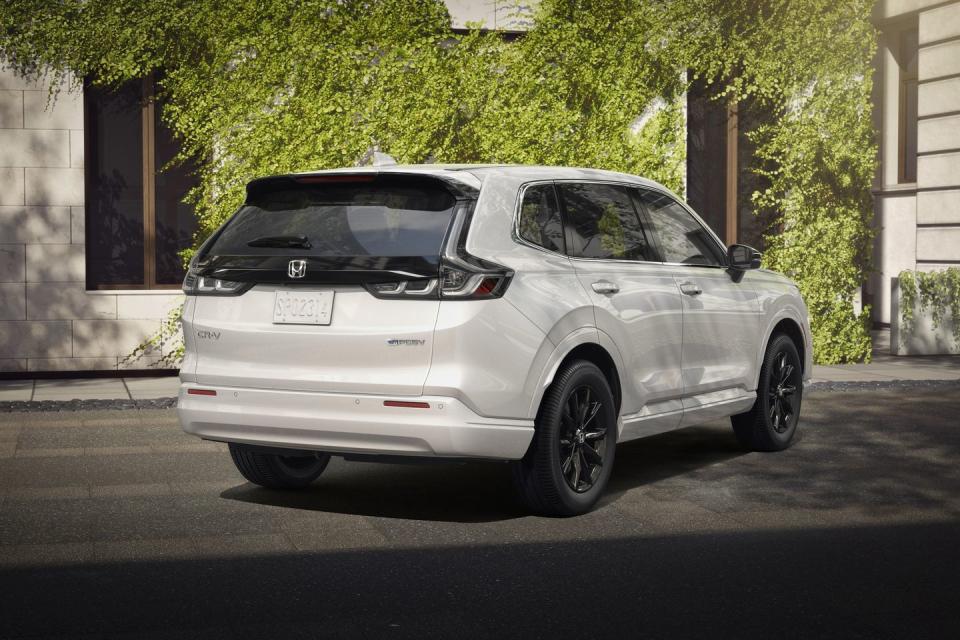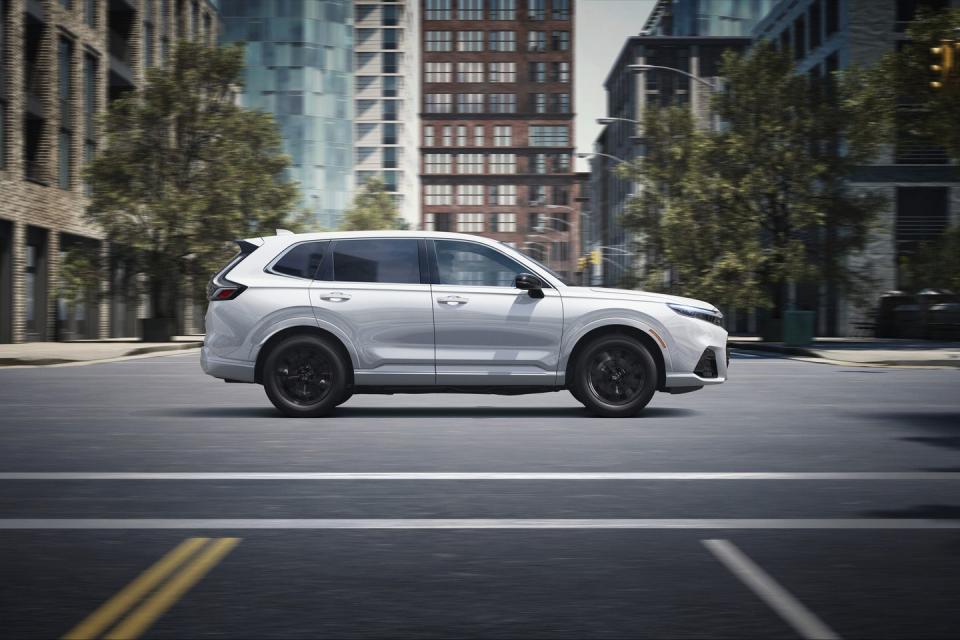Oh, the Flexibility! Honda CR-V e:FCEV Can Plug in When Hydrogen Runs Dry

There's a first time for everything. Honda's latest alt-fuel creation is the first hydrogen fuel-cell vehicle in the U.S. to also include a battery and a charge port. This is also the first time we can recall seeing a colon in a model name. One of these advancements is more interesting than the other.
Oh, the Flexibility!
Like the FCX and Clarity FCEV before it, the CR-V e:FCEV will be available here exclusively as a lease and only in California. That's where you'll find the overwhelming bulk of the country's light-vehicle hydrogen refueling infrastructure, but even that's sparse and trending in the wrong direction—Shell recently shuttered its H2 operations in Cali, reducing the number of stations in the state by seven, a 9 percent drop. For those times when you're not near a hydrogen station, or in the case they're out of fuel, the e:FCEV lets you plug in. Its 17.7-kWh battery, which can also be recharged using the fuel cell while on the go, is good for 29 all-electric miles, per the EPA, while the two hydrogen tanks combine for for an additional 241 miles of range. Recharging takes under two hours at 240 volts or about 10 hours on 120. Hydrogen refueling is much quicker.
The e:FCEV is Honda's attempt to break the chicken-and-egg infrastructure cycle—if hydrogen stations aren't proliferating (and they're not), then drivers need an alternative to that alternative fuel. In this case, the addition of a rechargeable battery is meant to reduce range anxiety. How the tables have turned.

It's not a coincidence that this latest fuel-cell vehicle uses the very popular CR-V crossover, Honda's bestselling model, as its basis. It's likely to attract a wider audience than the Clarity fuel-cell sedan while blending in better with traffic in SoCal and the Bay Area, where hydrogen stations are most concentrated.
About that initial-heavy name: Honda reps tell us the lowercase e preceding the colon is meant to denote that the vehicle is electrified. Elsewhere around the globe, the CR-V hybrid is badged e:HEV, while the not-for-U.S.-consumption plug-in-hybrid version is the e:PHEV. Fully parsed, that makes this one the Honda Comfortable Runabout Vehicle Electrified Fuel-Cell Electric Vehicle. We'll stick with e:FCEV.
A Nose Job and Bespoke Assembly
Another first: This is the initial and so far only consumer application of the fuel-cell stack developed through a Honda-General Motors joint venture. The powertrain modules are assembled in Michigan and then shipped down to Marysville, Ohio, where the e:FCEV is hand-assembled in the same Performance Manufacturing Center that turned out the NSX and a handful of special-edition Acura sedans and crossovers.

Honda had to lengthen the front overhang nearly four inches to accommodate the fuel cell, so the designers took the opportunity to restyle everything ahead of the A-pillars. Fenders and hood are aluminum to save weight, the hood is lower and a little longer, and the hexagonal grille opening extends lower down on the fascia, giving it a distinct look somewhere between that of the standard CR-V and the Prologue EV. The taillights get a clear treatment, and there's a new tailpipe-less rear fascia. Water, the only hydrogen-oxygen byproduct, exits inboard of one of the rear wheels. The Clarity spit its liquid out under the rear bumper, where it had a tendency to land on the footwear of anyone opening the rear hatch.
The 10,000-psi hydrogen tanks reside below and behind the rear seats, impinging not a whit on passenger space but reducing cargo capacity. You still get a flat-ish load floor with the rear seats folded thanks to an adjustable shelf that can sit level with the bump created by the topmost of the two carbon-fiber tanks. Honda didn't have a cargo-volume figure available, but we can confirm that it is less than the nonhybrid CR-V's 39 cubic feet.
Honda plans to produce around 300 e:FCEVs per year. It will be available in a single spec, Touring, meaning it's fully loaded. Interior differences are relatively minimal aside from updated digital interfaces. The e:FCEV is the only CR-V in the U.S. to include a fully digital gauge package (it measures 10.2 inches), as well as a heated steering wheel, the latter of which is borrowed from the global parts bin and covered in synthetic leather. Shift buttons replace the console lever we're used to in U.S.-spec CR-Vs. Paint is applied by humans in either white (to accommodate the expected municipal customers) or a handsome charcoal. The door is potentially open to add a more interesting hue in coming years.

Quiet Reassurance
The first thing we noticed after setting off in the e:FCEV was that the CR-V hybrid's artificial steering feel, which wants to click into faux detents off-center, is thankfully not present. In its place is the steering system from the European CR-V e:PHEV, which doesn't resist your inputs and feels more natural.
Then there's the quiet. Most of what you hear in the cabin is generated sound and the occasional gurgle of the fuel cell. The European e:PHEV also donates its battery pack, situated low down and providing some sound deadening.
Engineers retuned the suspension from the e:PHEV to accommodate the different weight distribution; Honda estimates the fuel-cell model will weigh about 500 pounds more than a comparable CR-V hybrid—for reference, the last CR-V Sport Touring hybrid we tested weighed in at 3914 pounds. The added weight wasn't too noticeable during our short drive, likely aided by the smoother steering setup.

Fuel-cell CR-Vs include the same drive modes as the hybrid—Normal, Sport, Econ, and Snow—as well as a handful of battery settings. Save keeps some battery-electric range in reserve, Charge runs the fuel cell to top up the battery, EV keeps the fuel cell off if possible, and Auto makes its own decisions. Fancy zinc-alloy paddles behind the steering wheel offer four levels of brake regeneration. Like in the CR-V hybrid, the effect is only temporary, allowing for brief stints of one-pedal driving before the vehicle reverts to a low-regen setting.
The e:FCEV is both heavier and less powerful than its turbo and hybrid brethren, making 174 horsepower, and its 229 pound-feet of torque about splits the difference between the other powertrains' totals. As such, the fuel-cell model's acceleration feels only adequate, although pedal response is smooth, and the modest torque hits immediately.
Zero Emissions, Two Fuel Sources
Honda hasn't announced pricing for the three-year lease yet but says the figure should be "attractive" to its target customers. If the Clarity FCEV is a guide, expect a monthly payment in the neighborhood of $400 with some hydrogen credit included.
You Might Also Like

 Yahoo Autos
Yahoo Autos 